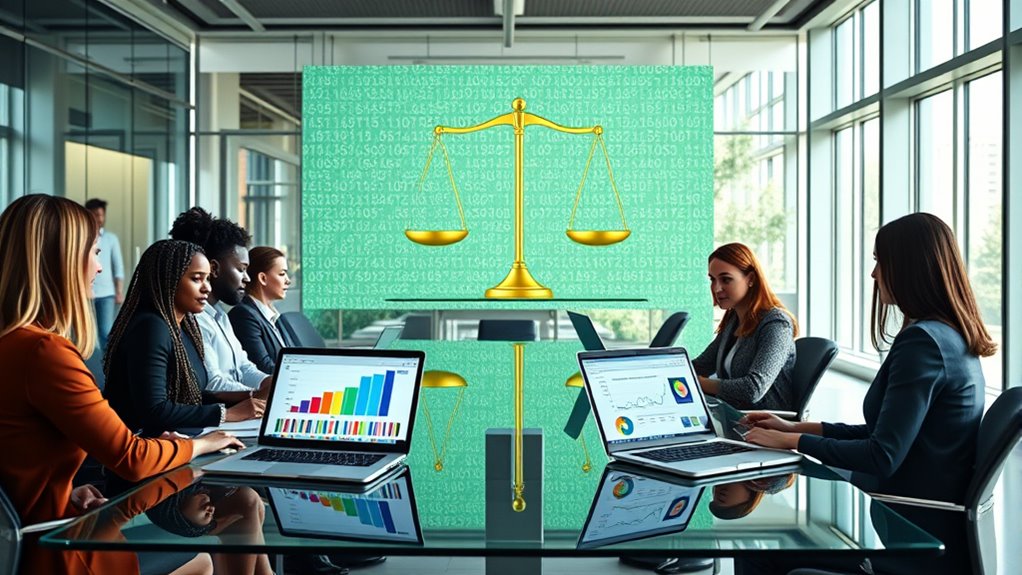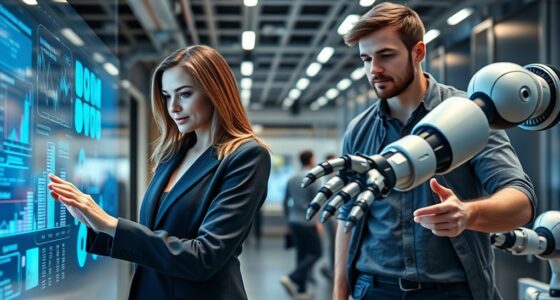AI hiring tools have the potential to make recruitment fairer by reducing human biases and standardizing evaluations. However, if not carefully managed, they can also reinforce existing prejudices or introduce new unfairness, especially if trained on biased data. Responsible use, regular audits, and human oversight are essential to guarantee fairness. Curious about how to maximize benefits and minimize risks? Continue exploring to learn more about building equitable AI-driven hiring practices.
Key Takeaways
- AI can reduce recruitment bias by standardizing evaluations, but only if trained on unbiased, diverse data.
- Proper oversight and audits are crucial to prevent AI from perpetuating existing stereotypes and unfair discrimination.
- AI-driven assessments improve diversity by identifying suitable candidates beyond traditional applicant pools.
- Biased training data can lead AI to reinforce stereotypes, increasing unfairness in hiring decisions.
- Responsible implementation, including human oversight, is essential to ensure AI promotes fairness rather than bias.

AI hiring tools are transforming the way companies find and evaluate talent. As a candidate or hiring manager, you’re likely noticing how these tools streamline processes, reduce time-to-hire, and improve overall efficiency. With over half of talent acquisition professionals already using AI, it’s clear that this technology is becoming a core part of recruitment strategies. By 2025, it’s predicted that 70% of organizations will incorporate AI into their hiring workflows, further cementing its role in the future of work. The AI in HR market is growing rapidly, from $6.05 billion in 2024 to nearly $7 billion in 2025, reflecting increased adoption and confidence in its capabilities. AI adoption in HR is increasing worldwide, making it a critical component of modern recruitment. AI tools automate repetitive tasks such as resume screening, saving recruiters around 8 hours per week, and filtering approximately 40% of applications before human review. This automation allows hiring managers to focus on more strategic activities, resulting in a significant boost in efficiency—98% of them report better hiring outcomes with AI. Candidates also benefit from faster responses and personalized communication, with 75% of job seekers preferring AI-driven processes for quick feedback. This accelerates the candidate experience, making it more engaging and satisfying. Additionally, the use of automated screening can help standardize the evaluation process, reducing subjective biases that may influence human decision-making.
AI’s role in candidate evaluation is equally impactful. It uses interview analytics and predictive models to increase hiring accuracy by 40% and improve talent matching by 67%. Today, 82% of recruiters rely on AI to review resumes, and many companies utilize AI for video interview analysis, helping assess candidates’ soft skills and cultural fit. Interestingly, 73% of hiring managers believe AI can identify suitable candidates for roles they didn’t even apply for, expanding talent pools and uncovering hidden potential.
However, the question remains whether AI makes hiring fairer or introduces new biases. On one hand, AI-powered tools are expected to cut recruitment bias by 50% and enhance workforce diversity by 35%. These benefits come from AI’s ability to standardize evaluations and remove some subjective human influences. On the other hand, AI can inadvertently reinforce biases if it’s trained on biased data or designed without fairness considerations. Without human oversight, there’s a risk of perpetuating stereotypes or unfair discrimination. Regular audits, diverse training data, and human judgment are essential to guarantee AI remains a tool for fairness rather than bias.
In the end, AI’s impact on hiring depends on how it’s deployed. When used responsibly, it can create a more equitable and efficient recruitment process. But unchecked, it risks amplifying existing inequalities. As a candidate or employer, understanding these nuances helps you navigate a landscape where technology promises fairness but requires vigilance to uphold it.
Frequently Asked Questions
How Do AI Hiring Tools Impact Diversity in the Workplace?
You might think AI hiring tools increase diversity, and they can—by expanding candidate pools and reducing human biases. However, if these tools aren’t carefully designed and monitored, they can reinforce existing biases, excluding marginalized groups. To truly improve diversity, you need to actively audit and adjust AI systems, ensuring they promote fairness. When used responsibly, AI can be a powerful ally in creating more inclusive workplaces.
What Legal Considerations Surround Ai-Driven Hiring Decisions?
You face complex legal considerations with AI-driven hiring decisions. While AI can streamline processes, it also risks bias and discrimination if not properly regulated. You must navigate a patchwork of state and local laws requiring transparency, bias audits, and record-keeping. Failing to comply can lead to lawsuits and penalties. So, you’re responsible for ensuring your AI tools meet legal standards, balancing efficiency with fairness to avoid legal pitfalls.
Can AI Bias Be Completely Eliminated in Recruitment?
You wonder if AI bias can ever be fully eliminated from recruitment. While responsible development and regular audits help reduce bias, complete elimination remains unlikely due to data limitations and algorithmic constraints. Human oversight is essential to catch biases AI might miss, but biases rooted in societal structures are hard to eradicate entirely. So, aiming for continuous improvement and transparency is your best approach to creating fairer hiring practices.
How Transparent Are AI Algorithms in the Hiring Process?
You might imagine AI algorithms as intricate, opaque machinery, making it hard to see how decisions are made. In reality, transparency varies widely—some tools disclose decision processes, fairness metrics, and bias audits, while others remain secretive “black boxes.” As a job candidate or employer, you often face limited insight into how AI evaluates your application, with many systems still lacking full transparency, leaving trust and fairness questions lingering.
What Steps Can Companies Take to Ensure Fair AI Usage?
To guarantee fair AI usage, you should start by using diverse training data that represents all candidate groups. Regularly audit and test your AI systems to spot biases early. Implement bias correction algorithms and keep your systems updated with new, unbiased data. Incorporate human oversight to review decisions, and ensure compliance with anti-discrimination laws. Involving stakeholders and using fairness metrics helps maintain transparency and fairness in your hiring processes.
Conclusion
As you navigate AI hiring tools, remember they’re like double-edged swords—powerful yet potentially perilous. They promise fairness but can hide biases like shadows in a storm. It’s up to you to wield them wisely, ensuring you don’t let unseen prejudices turn your hiring process into a minefield. With vigilant oversight, you can turn these tools into beacons of equality, shining brighter than a thousand suns, guiding you toward truly fair and unbiased hiring decisions.









